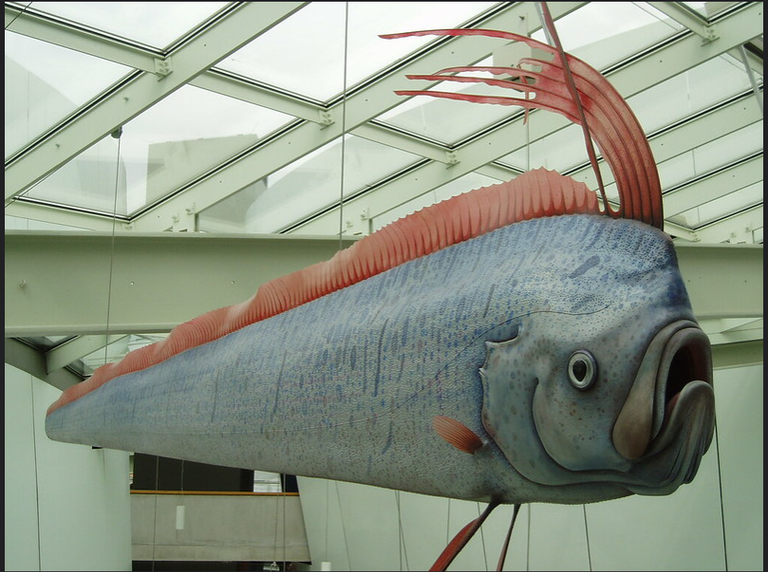Scrolling through X, I stumbled upon an intriguing post about an oarfish washing ashore in Mexico. For those unfamiliar with this deep-sea enigma, the oarfish is a long, ribbon-like fish that rarely appears at the ocean’s surface. Known as the Regalecus glesne, it holds the title for the longest bony fish in the world, reaching lengths of up to 36 feet! But what really makes the oarfish famous is the legend surrounding it - the so-called “doomsday fish.” How proven is this claim? Come along with me.
A Creature of the Deep
The oarfish is a resident of the mesopelagic zone. A dimly lit part of the ocean that extends from about 200 to 1,000 meters below the surface. This means they are seldom seen by humans unless they are sick, dying, or have been forced to the surface due to seismic activity or environmental changes. Their sinuous, silver bodies and crimson fins make them look almost mythical, a fitting appearance for a creature that has fueled folklore for centuries.
The “Doomsday” Connection
Across Japan and other coastal regions, the oarfish is believed to be a harbinger of natural disasters, particularly earthquakes and tsunamis. This belief stems from historical accounts of mass strandings before major seismic events. In 2011, multiple oarfish were reported to have washed ashore in Japan before the devastating Tōhoku earthquake and tsunami. More recently, sightings of oarfish in the Philippines and Mexico have reignited speculation about this eerie connection.
But is there any science behind this legend? Some researchers suggest that deep-sea creatures like the oarfish could be sensitive to shifts in tectonic activity, detecting underwater tremors before humans do. However, no definitive evidence links oarfish sightings to earthquakes. Most marine biologists argue that these strandings are more likely caused by ocean currents, temperature shifts, or natural illness.
A Gentle Giant of the Deep
Despite its fearsome reputation, the oarfish is completely harmless. Unlike the monstrous sea serpents of ancient lore, this deep-sea wanderer lacks teeth and survives by filtering small plankton and tiny crustaceans. Using its long, ribbon-like body, it undulates through the water in a mesmerizing display, rarely needing to swim at the surface. When it does, however, its sudden appearance can be quite the spectacle.
Why Are More Oarfish Washing Up?
There has been an increase in reported oarfish strandings in recent years. While some might rush to conclude that disasters are imminent, marine scientists offer a different perspective. Rising ocean temperatures, pollution, and changes in deep-sea ecosystems may be altering the oarfish’s natural habitat, forcing them closer to shore.
Additionally, sonar and underwater construction may also be disturbing these sensitive creatures. Since they rely on their lateral line system to navigate and detect vibrations, excessive noise pollution from human activity might be disorienting them, leading to accidental strandings.
The Oarfish in Myth and Media
Thanks to its rare appearances, the oarfish has played a role in maritime folklore for centuries. It is likely the inspiration for many sea serpent legends, as early sailors described seeing enormous, slithering creatures in the water. Even today, the oarfish continues to fuel our imagination, making appearances in pop culture, nature documentaries, and viral social media posts like the one that caught my attention.
Final Thoughts: A Mystery That Endures
So, does the oarfish truly signal disaster, or is it simply a misunderstood deep-sea wanderer? The science may lean towards the latter, but the mystery of this extraordinary fish persists. Whether you view it as an omen or a natural marvel, one thing is certain: every time an oarfish washes ashore, it captures the world’s curiosity, reminding us how little we know about the ocean’s hidden depths.
Thanks for reading.
Resources
- https://en.wikipedia.org/wiki/Oarfish
- https://www.forbes.com/sites/kionasmith/2019/06/23/oarfish-sightings-dont-predict-earthquakes-study-says/
- https://www.independent.co.uk/news/world/asia/japan-oarfish-washed-up-earthquake-tsunami-legend-a8759846.html
- https://www.dailymail.co.uk/sciencetech/article-14310149/Doomsday-fish-beach-fears-disaster-mexico.html
Posted Using INLEO

The rewards earned on this comment will go directly to the people( @loading ) sharing the post on Reddit as long as they are registered with @poshtoken. Sign up at https://hiveposh.com. Otherwise, rewards go to the author of the blog post.
Thanks for your contribution to the STEMsocial community. Feel free to join us on discord to get to know the rest of us!
Please consider delegating to the @stemsocial account (85% of the curation rewards are returned).
You may also include @stemsocial as a beneficiary of the rewards of this post to get a stronger support.
Congratulations @gentleshaid! You have completed the following achievement on the Hive blockchain And have been rewarded with New badge(s)
Your next target is to reach 280000 upvotes.
You can view your badges on your board and compare yourself to others in the Ranking
If you no longer want to receive notifications, reply to this comment with the word
STOP